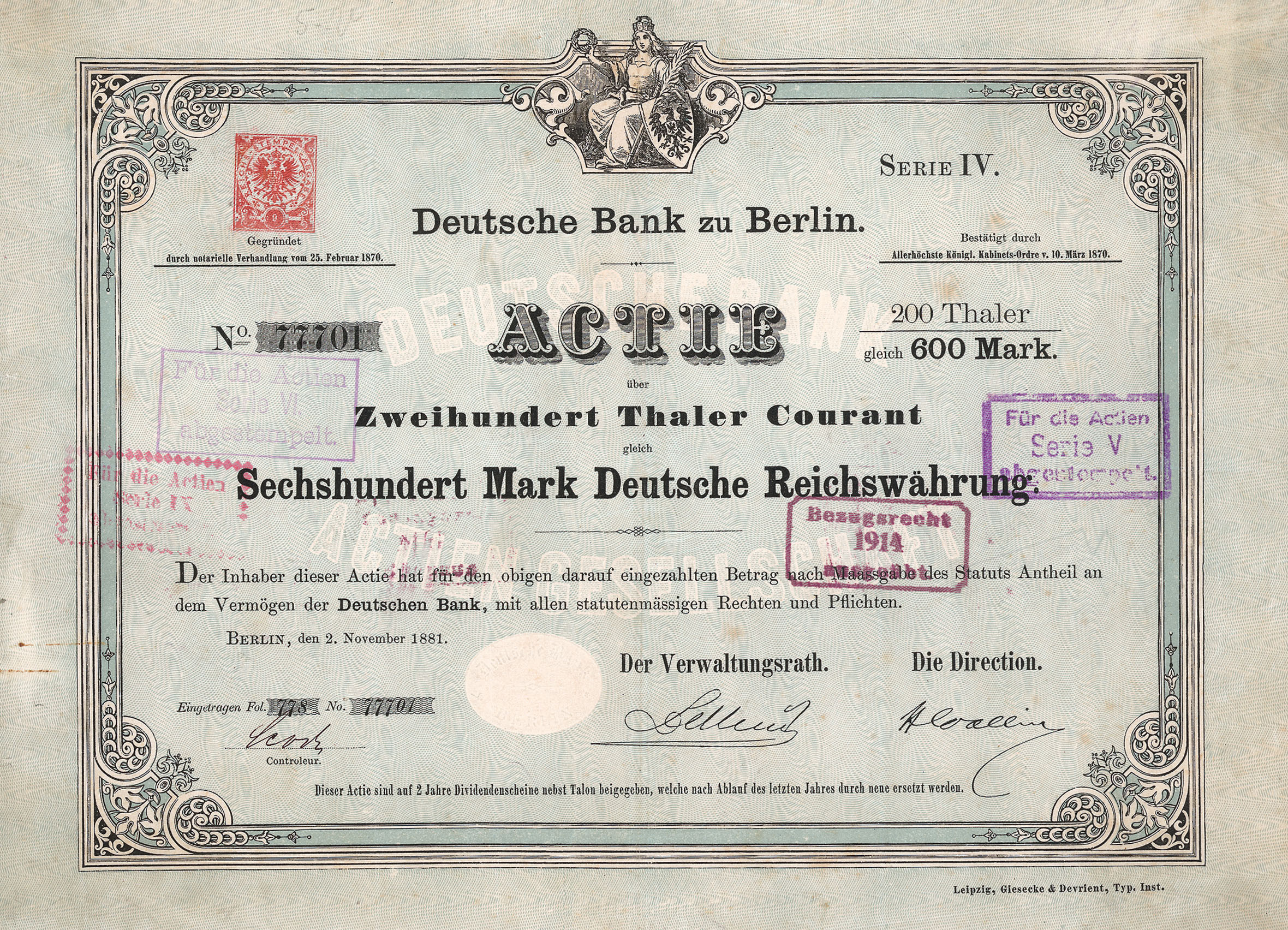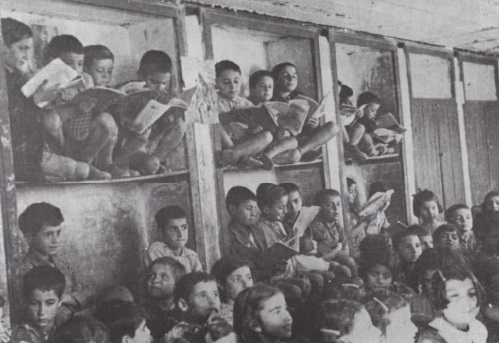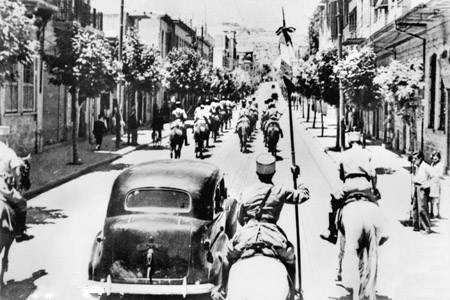|
Ayn Al-Arab
Kobani, also Kobane, officially Ayn al-Arab, is a Kurdish-majority city in the Ayn al-Arab District in northern Syria, lying immediately south of the Syria–Turkey border. As a consequence of the Syrian civil war, the city came under the control of the Kurdish-majority People's Protection Units (YPG) militia in 2012 and became the administrative center of the Kobani Canton, later transformed into Euphrates Region of the Autonomous Administration of North and East Syria. From September 2014 to January 2015, the city was under siege by the Islamic State of Iraq and the Levant. Most of the eastern parts of the city were destroyed and most of the population fled to Turkey. In 2015, many returned and reconstruction began. In mid October 2019, Kurdish forces accepted the entry of the Syrian Army and Russian Military Police in a bid to stop Turkey from invading the town. Prior to the Syrian Civil War, Kobani was recorded as having a population of close to 45,000. According ... [...More Info...] [...Related Items...] OR: [Wikipedia] [Google] [Baidu] |
Siege Of Kobanî
The siege of Kobanî was launched by the Islamic State (IS) on 13 September 2014, in order to capture the Kobanî Canton and its main city of Kobanî (also known as Kobanê or Ayn al-Arab) in northern Syria, in the ''de facto'' autonomous region of Rojava. By 2 October 2014, IS succeeded in capturing 350 Kurdish villages and towns in the vicinity of Kobanê, generating a wave of some 300,000 Kurdish refugees, who fled across the border into Turkey's Şanlıurfa Province. By January 2015, the number had risen to 400,000. The Kurdish People's Protection Units (YPG) and some Free Syrian Army (FSA) factions (under the Euphrates Volcano joint operations room), Peshmerga of the Kurdistan Regional Government, and American and US-allied Arab militaries' airstrikes began to recapture Kobane. On 26 January 2015, the YPG and its allies, backed by the continued US-led airstrikes, began to retake the city, driving IS into a steady retreat. The city of Kobanê was fully recaptured on 2 ... [...More Info...] [...Related Items...] OR: [Wikipedia] [Google] [Baidu] |
Euphrates Region
Euphrates Region, formerly Kobanî Canton, (; ; ) is the central of three original regions of the Autonomous Administration of North and East Syria, comprising Ayn al-Arab District of the Aleppo Governorate, Tell Abyad District of the Raqqa Governorate, and the westernmost tip of the Ras al-Ayn Subdistrict of the Ras al-Ayn District of Al-Hasakah Governorate. Euphrates Region unilaterally declared autonomy in January 2014 and since ''de facto'' is under direct democratic government in line with the polyethnic Constitution of Rojava. The region has two subordinate cantons, the Kobani Canton consisting of the Sarrin area (with the al-Jalabiya district subordinate to it) and the Kobani area (with the Şêran and the Qenaya Subdistricts subordinate to it), as well as the Tel Abyad Canton (with the Ain Issa and Suluk Subdistricts subordinate to it). Demographics The current population of Euphrates Region is unknown due to substantial refugee movements, but that of Kobane ... [...More Info...] [...Related Items...] OR: [Wikipedia] [Google] [Baidu] |
Baghdad Railway
Baghdad ( or ; , ) is the capital and List of largest cities of Iraq, largest city of Iraq, located along the Tigris in the central part of the country. With a population exceeding 7 million, it ranks among the List of largest cities in the Arab world, most populous cities in the Middle East and Arab world and forms 22% of the Demographics of Iraq, country's population. Spanning an area of approximately , Baghdad is the capital of its Baghdad Governorate, governorate and serves as Iraq's political, economic, and cultural hub. Founded in 762 AD by Al-Mansur, Baghdad was the capital of the Abbasid Caliphate and became its most notable development project. The city evolved into a cultural and intellectual center of the Muslim world. This, in addition to housing several key academic institutions, including the House of Wisdom, as well as a multi-ethnic and multi-religious environment, garnered it a worldwide reputation as the "Center of Learning". For much of the Abbasid era, duri ... [...More Info...] [...Related Items...] OR: [Wikipedia] [Google] [Baidu] |
Banca Commerciale Italiana
Banca Commerciale Italiana (BCI, colloquially known as Comit), founded in 1894, was a major Italian bank based in Milan. In 1999, it merged with the group recently formed by the combination of Cassa di Risparmio delle Provincie Lombarde and Banco Ambroveneto to form IntesaBCI, in which BCI temporarily became a sub-holding company. On 1 January 2003, the group's name changed to Banca Intesa, later Intesa Sanpaolo. History BCI's predecessor was the Credito Mobiliare, founded in 1862. On 10 October 1894, BCI was re-established as a private joint-stock bank with capital contributed by banks from Germany (78 percent), Austria (13 percent), and Switzerland (9 percent). These included Creditanstalt, Deutsche Bank, Darmstädter Bank, Berliner Handels-Gesellschaft, Disconto-Gesellschaft, and S. Bleichröder, with stakes from 10 to 13 percent each, whereas the other participating German and Swiss banks had individual stakes in the low single digits. The Germanic dominance didn’t ... [...More Info...] [...Related Items...] OR: [Wikipedia] [Google] [Baidu] |
Wiener Bankverein
The Wiener Bankverein or Bank-Verein (WBV, ) was a major bank in the Habsburg Monarchy and the First Austrian Republic, founded in 1869. In 1888 it was the fourth-largest bank of Austria-Hungary by market capitalization, behind the Austro-Hungarian Bank, the Länderbank, and the Creditanstalt. It merged with the troubled Creditanstalt in 1934 to form Creditanstalt-Bankverein. Wiener Bankverein is thus one of the many predecessor entities of UniCredit, as the latter in 2005 acquired Bank Austria which itself had merged with Creditanstalt in 1997. Habsburg era The Wiener Bankverein's creation was sponsored in 1869 by the Allgemeine Bodencreditanstalt, which had been established in Vienna in 1863. In 1871, with assistance from Anglo-Austrian Bank and Darmstädter Bank, it sponsored the creation of a joint-stock bank in Constantinople, the ; but that venture soon faltered and was acquired by the Imperial Ottoman Bank in 1874. It the late 19th century, the WBV became activ ... [...More Info...] [...Related Items...] OR: [Wikipedia] [Google] [Baidu] |
Imperial Ottoman Bank
The Ottoman Bank (), known from 1863 to 1925 as the Imperial Ottoman Bank (, ) and correspondingly referred to by its French acronym BIO, was a bank that played a major role in the financial history of the Ottoman Empire. By the early 20th century, it was the dominant bank in the Ottoman Empire, and one of the largest in the world. It was founded in 1856 as a British institution chartered in London, and reorganized in 1863 as a French–British venture with head office in Constantinople, on a principle of strict equality between British and French stakeholders. It soon became dominated by French interests, however, primarily because of the greater success of its offerings among French savers than British ones. In its early years, the BIO was principally a lender to the Ottoman government with a monopoly on banknote issuance and other public-interest roles, including all treasury operations of the Ottoman state under an agreement ratified in February 1875 that was however never f ... [...More Info...] [...Related Items...] OR: [Wikipedia] [Google] [Baidu] |
Deutsche Bank
Deutsche Bank AG (, ) is a Germany, German multinational Investment banking, investment bank and financial services company headquartered in Frankfurt, Germany, and dual-listed on the Frankfurt Stock Exchange and the New York Stock Exchange. Deutsche Bank was founded in 1870 in Berlin. From 1929 to 1937, following its merger with Disconto-Gesellschaft, it was known as ''Deutsche Bank und Disconto-Gesellschaft'' or DeDi-Bank. Other transformative acquisitions have included those of Mendelssohn & Co. in 1938, Morgan, Grenfell & Company, Morgan Grenfell in 1990, Bankers Trust in 1998, and Deutsche Postbank in 2010. As of 2018, the bank's network spanned 58 countries with a large presence in Europe, the Americas, and Asia. It is a component of the DAX stock market index and is often referred to as the List of banks in Germany, largest German banking institution, with Deutsche Bank holding the majority stake in DWS Group for combined assets of 2.2 trillion euros, rivaling even Spa ... [...More Info...] [...Related Items...] OR: [Wikipedia] [Google] [Baidu] |
Armenians In Syria
The Armenians in Syria are Syrian citizens of either full or partial Armenians, Armenian descent. Syria and the surrounding areas have often served as a refuge for Armenians who fled from wars and persecutions such as the Armenian genocide. However, there has been an Armenian presence in the region since the Byzantine era. According to the Ministry of Diaspora of Armenia, the estimated number of Armenians in Syria is 100,000, with more than 60,000 of them centralized in Aleppo. With other estimates by Armenian foundations in Syria putting the number around 70–80,000. However, since the start of the conflict, 16,623 Syrian citizens of ethnic Armenian background have arrived in Armenia. Of these displaced persons, 13,000 remained and found protection in Armenia as of July 2015. The government is offering several protection options including simplified naturalization by Armenians in the Middle East, Armenian descent (15,000 persons acquired Armenian nationality law, Armenian citiz ... [...More Info...] [...Related Items...] OR: [Wikipedia] [Google] [Baidu] |
Syrian Turkmen
Syrian Turkmen, also called Syrian Turks or Syrian Turkish people (; ) are Syrian citizens of Turkish origin who mainly trace their roots to Anatolia (i.e. modern Turkey). Turkish-speaking Syrian Turkmen make up the third largest ethnic group in the country, after the Arabs and Kurds respectively.. The majority of Syrian Turkmen are the descendants of migrants who arrived in Syria during Ottoman rule (1516–1918);. however, there are also many Syrian Turkmen who are the descendants of earlier Turkish settlers that arrived during the Seljuk (1037–1194) and Mamluk (1250–1517) periods. Some estimates indicate that if Arabized Turkmen (those who no longer speak Turkish as their main language) are taken into account, they form the second-largest group in the country.. The majority of Syrian Turkmen are Sunni Muslims. Syrian Turkmen share common genealogical and linguistic ties with the Turkish people in Turkey and Iraqi Turkmen, but do not identify themselves with the Tur ... [...More Info...] [...Related Items...] OR: [Wikipedia] [Google] [Baidu] |
Arab
Arabs (, , ; , , ) are an ethnic group mainly inhabiting the Arab world in West Asia and North Africa. A significant Arab diaspora is present in various parts of the world. Arabs have been in the Fertile Crescent for thousands of years. In the 9th century BCE, the Assyrians made written references to Arabs as inhabitants of the Levant, Mesopotamia, and Arabia. Throughout the Ancient Near East, Arabs established influential civilizations starting from 3000 BCE onwards, such as Dilmun, Gerrha, and Magan (civilization), Magan, playing a vital role in trade between Mesopotamia, and the History of the Mediterranean region, Mediterranean. Other prominent tribes include Midian, ʿĀd, and Thamud mentioned in the Hebrew Bible, Bible and Quran. Later, in 900 BCE, the Qedarites enjoyed close relations with the nearby Canaan#Canaanites, Canaanite and Aramaeans, Aramaean states, and their territory extended from Lower Egypt to the Southern Levant. From 1200 BCE to 110 BCE, powerful ... [...More Info...] [...Related Items...] OR: [Wikipedia] [Google] [Baidu] |
Russian Military Police
The Military Police of Russia (, VP) is the uniformed law enforcement branch of the Russian Armed Forces, which is known by the official name of Military Police of the Armed Forces of the Russian Federation (), and it is operated by the Ministry of Defence. The Chief of Military Police is ''ex officio'' the First Deputy Minister of Defence. The current Chief of Military Police is Colonel General Sergey Kuralenko who replaced Lieutenant General Vladimir Ivanovsky since February 2020. Structure and Mission Mission The Army's Military Police provide an important function in the full spectrum of Army operations as a member of the Maneuver, Fires, and Effects division. The Military Police provides expertise in police, detainment and stability operations in order to enhance security and enable mobility. The Army's Military Police can be utilized in direct combat and during peacetime. The Military Police have five main functions: # Maneuver and mobility support operations # Area ... [...More Info...] [...Related Items...] OR: [Wikipedia] [Google] [Baidu] |
Syrian Army
The Syrian Army is the land force branch of the Syrian Armed Forces. Up until the fall of the Assad regime, the Syrian Arab Army existed as a land force branch of the Syrian Arab Armed Forces, which dominanted the military service of the four uniformed services, controlling the most senior posts in the armed forces, and had the greatest manpower, approximately 80 percent of the combined services.. The Syrian Army originated in local military forces formed by the French after World War I, after France obtained a mandate over the region. It officially came into being in 1945, before Syria obtained full independence the following year and 2 years after official independance. After 1946, it played a major role in Syria's governance, mounting six military coups: two in 1949, including the March 1949 Syrian coup d'état and the August 1949 coup by Colonel Sami al-Hinnawi, and one each in 1951, 1954, 1963, 1966, and 1970. It fought four wars with Israel (1948, the Six-Day War in ... [...More Info...] [...Related Items...] OR: [Wikipedia] [Google] [Baidu] |









